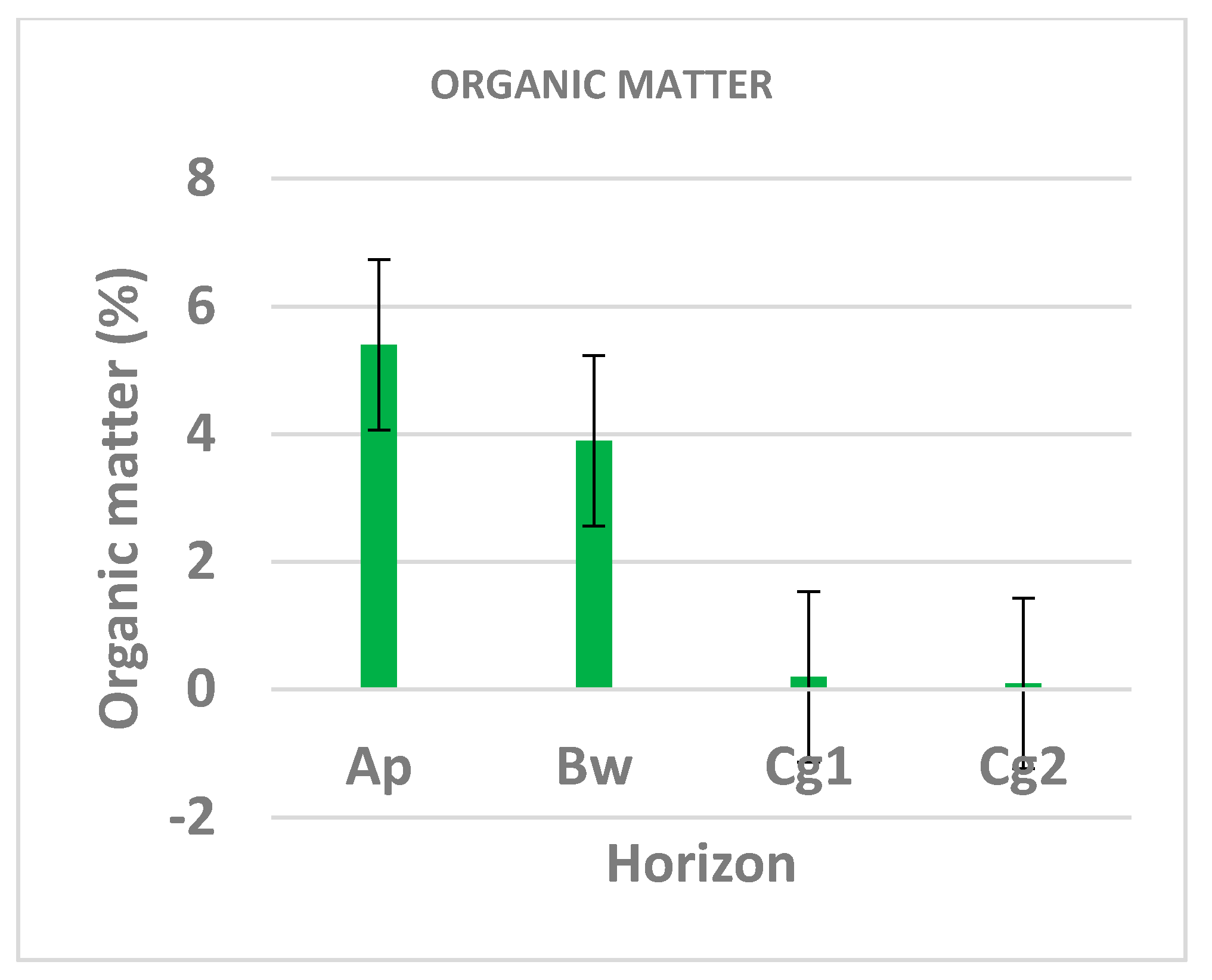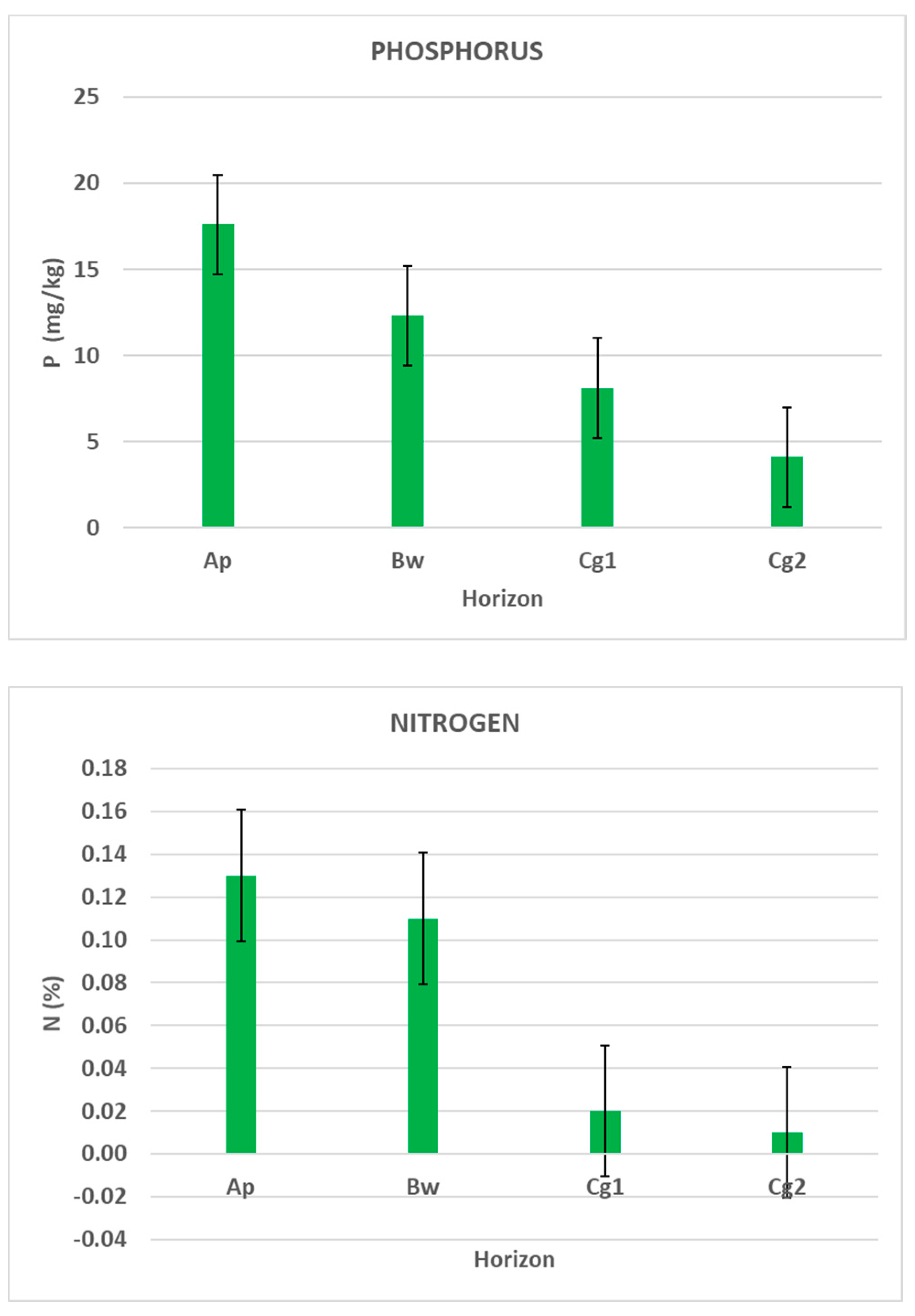An Environmental Approach to Understanding the Expansion of Future Vineyards: Case Study of Soil Developed on Alluvial Sediments
Abstract
:1. Introduction
2. Materials and Methods
3. Results
4. Discussion
5. Conclusions
Author Contributions
Funding
Institutional Review Board Statement
Informed Consent Statement
Data Availability Statement
Acknowledgments
Conflicts of Interest
References
- Hualin, X.; Yingqian, H.; Qianru, C.; Yanwei, Z.; Qing, W. Prospects for Agricultural Sustainable Intensification: A Review of Research. Land 2019, 8, 1–27. [Google Scholar]
- Yaalon, D.H. Soils in the Mediterranean region: What makes them different? Catena 1997, 28, 157–169. [Google Scholar]
- Jiménez-Ballesta, R.; Bravo, S.; Amorós, J.A.; Pérez-de los Reyes, C.; García-Pradas, J.; García-Navarro, F.J. Understanding the Quality of Local Vineyard Soils in Distinct Viticultural Areas: A Case Study in Alcubillas (La Mancha, Central Spain). Agriculture 2020, 10, 66. [Google Scholar] [CrossRef] [Green Version]
- Amorós, J.A.; Bravo, S.; García-Navarro, F.J.; Pérez-de-los-Reyes, C.; Chacón, J.L.; Martínez, J.; Jiménez-Ballesta, R. Atlas de Suelos de Castilla-La Mancha, 1st ed.; Globalcaja and Universidad de Castilla-La Mancha: Ciudad Real, Spain, 2015; p. 318. [Google Scholar]
- Jiménez-Ballesta, R.; Pérez-De-Los-Reyes, C.; Amorós, A.; Bravo, S.; García-Navarro, F.J. Pedodiversity in Vineyards of Castilla-La Mancha, Spain. In Proceedings of the XII Congreso Internacional Terroir, Zaragoza, Spain, 18–22 June 2018; Volume 50, pp. 324–328, ISBN 978-84-09-03040-8. [Google Scholar]
- MAPA. Ministerio de Agricultura, Ganadería y Pesca. Anuario de Estadística Agraria y Alimentaria. 2019. Available online: https://www.mapa.gob.es/es/estadistica/temas/publicaciones/anuario-de-estadistica/default.aspx (accessed on 26 September 2020).
- Sugár, E.; Fodor, N.; Sándor, R.; Bónis, P.; Vida, G.; Árendás, T. Spelt Wheat: An Alternative for Sustainable Plant Production at Low N-Levels. Sustainability 2019, 11, 6726. [Google Scholar] [CrossRef] [Green Version]
- Dubey, R.K.; Dubey, P.K.; Chaurasia, R.; Rao, C.S.; Abhilash, P.C. Impact of Integrated Agronomic Practices on Soil Fertility and Respiration on the Indo-Gangetic Plain of North India. Agronomy 2021, 11, 402. [Google Scholar] [CrossRef]
- Morlat, R.; Jacquet, A. The Soil Effects on the Grapevine Root-System in Several Vineyards of the Loire Valley (France). VITIS 1993, 32, 35–42. [Google Scholar]
- Van Leeuwen, C.; Friant, P.; Choné, X.; Tregoat, O.; Koundouras, S.; Dubourdieu, D. Influence of climate, soil, and cultivar on terroir. Am. J. Enol. Vitic. 2004, 55, 207–217. [Google Scholar]
- Lanyon, D.; Cass, A.; Hansen, D. The Effect of Soil Properties on Vine Performance; Technical Report; CSIRO Land and Water: Adelaide, Australia; Clayton, Australia, 2004; p. 54. [Google Scholar]
- Greenough, J.D.; Mallory-Greenough, L.M.; Fryer, B.J. Geology and wine 9: Regional trace element fingerprinting of Canadian wines. Geosci. Can. 2005, 32, 129–137. [Google Scholar]
- De Andres-De-Prado, R.; Yuste-Rojas, M.; Sort, X.; Andres-Lacueva, C.; Torres, M.; Lamuela-Raventos, R.M. Effect of soil type on wines produced from Vitis vinifera L. cv Grenache in commercial vineyards. J. Agric. Food Chem. 2007, 55, 779–786. [Google Scholar] [CrossRef]
- Wang, R.; Sun, Q.; Chang, Q. Soil Types Effect on Grape and Wine Composition in Helan Mountain Area of Ningxia. PLoS ONE 2015, 10, e0116690. [Google Scholar] [CrossRef]
- Jiménez-Ballesta, R.; Bravo, S.; Amorós, J.A.; Pérez-de los Reyes, C.; García-Pradas, J.; Sánchez Ormeño, M.; García-Navarro, F.J. Soil Genesis and Vineyard Suitability for Viticulture in Zones under Mediterranean Environment. Eurasian Soil Sci. 2021, 54, 1152–1160. [Google Scholar] [CrossRef]
- White, R.E. Understanding Vineyard Soils, 2nd ed.; Oxford University Press: Oxford, UK, 2009; p. 280. [Google Scholar]
- Seguin, G. “Terroirs” and pedology of wine growing. Experientia 1986, 42, 861–873. [Google Scholar] [CrossRef]
- Walia, C.; Chamuah, S. Characteristics, classification and suitability for land use planning of foothill soils. J. Indian Soc. Soil Sci. 1990, 38, 286–292. [Google Scholar]
- Brubaker, S.C.; Gones, A.J.; Lewis, D.T.; Frank, K. Soil properties associated with landscape position. Soil Sci. Soc. Am. J. 1993, 57, 235–239. [Google Scholar] [CrossRef]
- Garcia-Navarro, F.J.; Amorós, J.A.; Pérez-De-Los-Reyes, C.; García-Pradas, J.; Bravo, S.; Jiménez-Ballesta, R. Informe sobre los Suelos de la Cooperativa San Isidro. Villanueva de Alcardete (Toledo); Denominación de Origen Uclés; DO Uclés-UCLM: Ciudad Real, Spain, 2018. [Google Scholar]
- FAO. Guidelines for Soil Description, 4th ed.; FAO/UNESCO: Rome, Italy, 2006; p. 108. [Google Scholar]
- International Organization for Standardization, Geneva. ISO 10390:2005: Soil Quality—Determination of pH. 2005. Available online: https://www.iso.org/standard/40879.html (accessed on 16 September 2021).
- Nelson, D.W.; Sommers, L.E. Total Carbon, Organic Carbon and Organic Matter; ASA-SSSA: Madison, WI, USA, 1982; pp. 539–579. [Google Scholar]
- Bremner, J.M.; Mulvaney, C.S. Nitrogen Total. In Methods of Soil Analysis Part 2, Chemical and Microbiological Properties; ASA-SSSA: Madison, WI, USA, 1982; pp. 621–622. [Google Scholar]
- Drouineau, G. Dosage rapide du calcaire actif de sols. Ann. Agron. 1942, 12, 441–450. [Google Scholar]
- Thomas, G.W. Exchangeable Cations. In Methods of Soil Analysis, Part 2; ASA-SSSA: Madison, WI, USA, 1982; pp. 159–165. [Google Scholar]
- Olsen, S.R.; Cole, C.V.; Watanabe, F.S.; Dean, L.A. Estimation of Available Phosphorus in Soils by Extraction with Sodium Bicarbonate; USDA: Washington, DC, USA, 1954; p. 22.
- Blake, G.R.; Hartge, K.H. Bulk density. In Methods of Soil Analysis, Part 1: Physical and Mineralogical Methods, 2nd ed.; ASA-SSSA: Madison, WI, USA, 1986; pp. 363–382. [Google Scholar]
- Leake, S. Soils for Olive Planting: Choosing and Improving. Sydney, Sydney Environment, Soil Laboratory Pty Ltd. 2001. Available online: http://www.sesl.com.au/uploads/articles/Soils_for_Olive_Planting.pdf (accessed on 11 September 2019).
- IUSS Working Group WRB. World Reference Base for Soil Resources: International Soil Classification System for Naming Soils and Creating Legends for Soil Maps; World Soil Resources Reports No. 106; FAO: Rome, Italy, 2015. [Google Scholar]
- Soil Survey Staff. Key to Soil Taxonomy, 12th ed.; USDA-Natural Resources, Conservation Service: Washington, DC, USA, 2014; p. 379.
- Bravo, S.; Amorós, J.A.; Pérez-De-Los-Reyes, C.; García, F.J.; Moreno, M.M.; Sánchez-Ormeño, M.; Higueras, P. Influence of the soil pH in the uptake and bioaccumulation of heavy metal (Fe, Zn, Cu, Pb and Mn) and other elements (Ca, K, Al Sr and Ba) in vine leaves, Castilla-La Mancha (Spain). J. Geochem. Explor. 2017, 174, 79–83. [Google Scholar] [CrossRef]
- Sanyal, S.K.; De Datta, S.K. Chemistry of phosphorus transformation in soils. In Advances in Soil Science; Springer: Berlin/Heidelberg, Germany, 1991; Volume 16, pp. 1–94. [Google Scholar]
- Kobayashi, A.; Iwasaki, K.; Sato, Y. Growth and nutrient absorption of grapes as affected by soil aeration. 1. With non-boaring Delaware grapes. J. Jpn. Soc. Hortic. Sci. 1963, 32, 33–37. [Google Scholar] [CrossRef] [Green Version]
- Iwasaki, K.; Kadoya, K.; Kuraoka, T. Growth and nutrient adsorption of Dalaware grapes as affected by soil oxygen. IV. Comparison of the effect among different soil properties. J. Jpn. Soc. Hortic. Sci. 1966, 35, 15–22. [Google Scholar] [CrossRef]
- Myburgh, P.A.; Moolman, J.H. Ridging-a soil preparation practice to improve aeration of vineyard soils. S. Afr. J. Plant Soil 1991, 8, 189–193. [Google Scholar] [CrossRef] [Green Version]
- Myburgh, P.A.; Moolman, J.H. The effect of ridging on the soil water status of a waterlogged vineyard soil. S. Afr. J. Plant Soil 1991, 8, 184–188. [Google Scholar] [CrossRef]
- Myburgh, P.A. Effect of ridging on the performance of young grapevines on a waterlogged soil. S. Afr. J. Enol. Vitic. 1994, 15, 3–8. [Google Scholar] [CrossRef] [Green Version]
- Stevens, R.M.; Harvey, G.; Partington, D.L. Irrigation of grapevines with saline water at different growth stages: Effects on leaf, wood and juice composition. Aust. J. Grape Wine Res. 2011, 17, 239–248. [Google Scholar] [CrossRef]
- Walker, R.R.; Blackmore, D.H.; Clingeleffer, P.R.; Emanuelli, D. Rootstock type determines tolerance of Chardonnay and Shiraz to long-term saline irrigation. Aust. J. Grape Wine Res. 2014, 20, 496–506. [Google Scholar] [CrossRef]
- Marschner, H. Mineral Nutrition of Higher Plants; Academic Press: London, UK, 1986. [Google Scholar]
- Hickinbotham, A.R.; Williams, R.A. Soluble salts in non-irrigated vineyards. S. Aust. J. Agric. 1933, 36, 217–223. [Google Scholar]
 .
.
 .
.



| Soil Type FAO/Soil Taxonomy | Location Coordinates | Altitude (m) | Parent Material | Vegetation Use | Geomorphic Surface | Slope | Drainage |
|---|---|---|---|---|---|---|---|
| Gleyic Fluvisol (Calcaric, Humic)/ Fluventic Haploxerept | GPS: 39°42′29.0″ (N)–03°00′46.0″ (W) UTM: (30 s) 0498908 (x)–4395356 (y) | 715 | Fluvial loamy sediments | Vineyard (Tempranillo) | Alluvial floodplain | Flat | Imperfectly drained |
| Horizons/ Depth (cm) | Color (dry) | Structure | Consistence | Roots | Pores | Limit | Stoniness (%) |
| Ap (0–35) | 10 YR 5/3 (d) 10 YR 4/3 (w) | Blocky subangular thick | Slightly sticky, no plastic, loose and slightly hard | Few fines | Common fines | Gradual and wavy | 5 |
| Bw (35–83) | 10 YR 4/3 (d and w) | Massive | Slightly sticky, slightly plastic, loose and slightly hard | Few | Few, all sizes | Diffuse and wavy | 2 |
| Cg1 (83–111) | 2.5 Y 6/1 (d) 2.5 Y 5/1 (w) | Massive | Slightly sticky, slightly plastic, firm and slightly hard | Without | Few, all sizes | Net and plane | 0 |
| Cg2 (>111) | 2.5 Y 7/3 (d) 2.5 Y 6/2 (w) | Massive | Very compact and slightly hard | Without | Few, all sizes | Net and plane | 0 |
| Ap | Bw | Cg1 | Cg2 | ||
|---|---|---|---|---|---|
| Depth (cm) | 0–35 | 35–83 | 83–111 | >111 | |
| Bulk density (g/cc) | 0.90 | 1.24 | 1.46 | n.d. | |
| Texture (to the touch) | Silty loam | Silty loam | Silty loam | Silty loam | |
| C/N ratio | 11.4 | 13.5 | n.d. | n.d. | |
| pH (water 1:2.5) | 7.6 | 7.6 | 8.0 | 8.2 | |
| Electrical conductivity (dS/m) | 1.49 | 1.91 | 2.38 | 1.14 | |
| CaCO3 Content (%) | 18.2 | 18.8 | 24.6 | 10.5 | |
| Active limestone (%) | 13.1 | 15.1 | 12.7 | 11.0 | |
| Cation Exchange Complex (cmol+/kg) | Ca2+ | 13.5 | 10.8 | n.d. | n.d. |
| Mg2+ | 0.4 | 0.3 | n.d. | n.d. | |
| K+ | 0.8 | 0.3 | n.d. | n.d. | |
| Na+ | 0.1 | 0.1 | n.d. | n.d. | |
| CEC | 14.8 | 11.5 | 10.4 | n.d. | |
| V (%) | 100 | 100 | n.d. | n.d. | |
Publisher’s Note: MDPI stays neutral with regard to jurisdictional claims in published maps and institutional affiliations. |
© 2021 by the authors. Licensee MDPI, Basel, Switzerland. This article is an open access article distributed under the terms and conditions of the Creative Commons Attribution (CC BY) license (https://creativecommons.org/licenses/by/4.0/).
Share and Cite
Jiménez-Ballesta, R.; Bravo, S.; Amorós, J.A.; Pérez-de-los-Reyes, C.; García-Pradas, J.; Sánchez, M.; García-Navarro, F.J. An Environmental Approach to Understanding the Expansion of Future Vineyards: Case Study of Soil Developed on Alluvial Sediments. Environments 2021, 8, 96. https://doi.org/10.3390/environments8090096
Jiménez-Ballesta R, Bravo S, Amorós JA, Pérez-de-los-Reyes C, García-Pradas J, Sánchez M, García-Navarro FJ. An Environmental Approach to Understanding the Expansion of Future Vineyards: Case Study of Soil Developed on Alluvial Sediments. Environments. 2021; 8(9):96. https://doi.org/10.3390/environments8090096
Chicago/Turabian StyleJiménez-Ballesta, Raimundo, Sandra Bravo, Jose Angel Amorós, Caridad Pérez-de-los-Reyes, Jesus García-Pradas, Monica Sánchez, and Francisco Jesús García-Navarro. 2021. "An Environmental Approach to Understanding the Expansion of Future Vineyards: Case Study of Soil Developed on Alluvial Sediments" Environments 8, no. 9: 96. https://doi.org/10.3390/environments8090096
APA StyleJiménez-Ballesta, R., Bravo, S., Amorós, J. A., Pérez-de-los-Reyes, C., García-Pradas, J., Sánchez, M., & García-Navarro, F. J. (2021). An Environmental Approach to Understanding the Expansion of Future Vineyards: Case Study of Soil Developed on Alluvial Sediments. Environments, 8(9), 96. https://doi.org/10.3390/environments8090096







